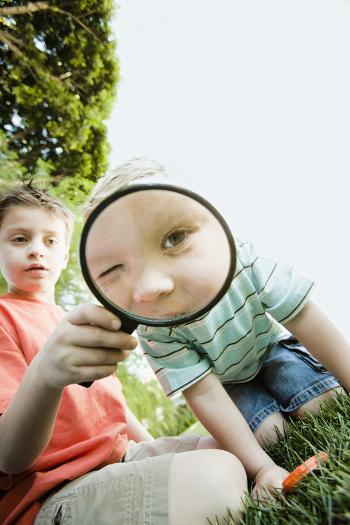I spy with my little eye
Duration/age

I spy with my little eye something that is green, soft and found outside!
Next time you are waiting for an appointment, have some spare time, or travelling on the bus, play I-spy with your child.
There are many different ways you can play I-spy. You might play using the first letter of the word, the colour and shape of the object or what you use it for. How you play will change depending on your child’s age and how interested they are.
I spy with my little eye something I can drink with.
To extend the game you can take turns with your child, showing them different ways to ask questions.
I spy with my little eye something that is green, soft and found outside!
Is it something we can eat?
Can I roll on it?
Materials you will need
- Your eyes
- Your ears
- Your imagination
Alternative tools
- Where’s Wally books
- I-spy storybooks
Skills this activity improves
Why does this matter?
Children have a natural sense of wonder about the world around them. Talking about the things you notice around you helps children to make sense of what they observe, develop their observation skills and language to describe what they see.
As they play I-spy, they are beginning to notice and compare what is the same or different around them. When they do this they are developing descriptive language and experimenting with how to ask questions to get more information.
When they compare what is the same or different they will be using mathematical language to describe what they see and to learn new things.
What does this lead to?
Some children are naturally curious and creative, taking risks in their learning. Children who are naturally curious and creative often notice and wonder about what they see around them. They will ask questions and create their own answers. These children have a disposition to be creative and curious.
Talking about and exploring the natural and everyday environment with your child will help them to develop the skills to notice, take risks and ask questions.
When children notice differences and objects around them, they are able to sort and group them by attributes. There are many different ways that an object can be sorted or grouped. You might group them by:
- size – Is it big or small?
- function – Does it fly or crawl? Does it hold water? Can I drink from it?
- number – How many legs does it have? Is there more than one? How many are there?
- colour – Does it have one colour or lots of colours?
- where it is found – Is it above the ground or below the ground? Is it inside or outside?
- texture – Is it soft and smooth or hard and spiky?
Sorting objects into smaller groups helps children to make decisions about how to interact with the objects. The grouping of the objects creates information and data. The information helps to tell us what to do and how to act.
Language to use
- Look, spy, see, notice, observe
- Describe, explain
- Size, big, small, tiny, enormous, huge, medium
- Colour, light, dark, shade, pastel
- Primary colour, red, yellow, blue
- Shape
- Position, under, over, next to, near, below, behind, inside, outside
- Function
- Kitchen, lounge room, garden, bedroom, window
Questions to use
- Can you see something that is round and can be thrown, caught or kicked?
- Can you find something that you can climb up and then roll down?
- Can you see something I can wear on my head?
- Can you find something you can crawl into?
- Can you see something we can fill with water?
Useful tips
- You might also like the activities We went walking, Travelling with children and Pattern walk.
- For more information about developing language and literacy skills see the activities Reading together and Singing with your baby.
- Remember to talk to your child in your home language.
More ideas
Borrow I-spy books from your local library.
Variation by age
Birth to two year olds
- Place different objects onto a tray, such as a cup, spoon or bowl. Ask questions about the objects until your child can work out which one it is.
- You could play I-spy using family members or pets. I-spy someone with long hair.
- Make your own I-spy book.
Three to five year olds
- Place different objects onto a tray, such as a cup, spoon or bowl. Ask questions about the objects until your child can work out which one it is.
- You could play I-spy using family members or pets. I-spy someone with long hair.
- Make your own I-spy book.


